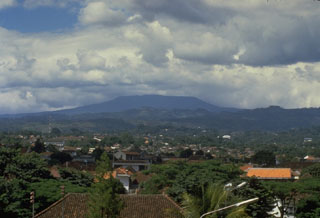Report on Tangkuban Parahu (Indonesia) — August 2003
Bulletin of the Global Volcanism Network, vol. 28, no. 8 (August 2003)
Managing Editor: Edward Venzke.
Tangkuban Parahu (Indonesia) Elevated seismicity during August-October 2002
Please cite this report as:
Global Volcanism Program, 2003. Report on Tangkuban Parahu (Indonesia) (Venzke, E., ed.). Bulletin of the Global Volcanism Network, 28:8. Smithsonian Institution. https://doi.org/10.5479/si.GVP.BGVN200308-263090
Tangkuban Parahu
Indonesia
6.77°S, 107.6°E; summit elev. 2084 m
All times are local (unless otherwise noted)
In August and September 2002 Tankubanparahu showed its first elevated seismicity since 1992 (BGVN 27:09). This activity continued in October of 2002. The volcano is at Alert Level 2.
From September through 6 October, volcanic events dominated seismicity, particularly during the week of 16-22 September, when there were 331 shallow volcanic [B-type] events. Crater fumarole temperatures of 92-95°C were recorded at Domas and Ratu craters; the hotspring temperature at Ciater was 47°C. H2S concentrations were above detections limits, ranging from 80 to more than 100 ppm at Ratu; more than 80 ppm H2S was also recorded at Jagal. A "thin white ash plume" was observed to rise 2.5 m, and a whizzing sound could be heard 50 m away. A strong sulfur smell and sulfur sublimation were noted.
Between 7 and 13 October, volcanic events again dominated seismic activity, but numbers were lower than the previous week, with 151 B-type events, down from 199, and four A-type events, down from five. Tectonic activity occurred at the same rate as the previous week, with 21 events. The following week volcanic activity again dropped, with 57 shallow volcanic (B-type) events. However, deep volcanic (A-type) events increased slightly, to 15. Observations during the week included a "white-thin ash plume" to 2 m and medium-strong gas pressure. A strong sulfur smell and yellow sublimation were also noted. The fumarole temperature at Ratu crater was 95°C.
Shallow volcanic earthquakes increased through the week of 21-27 October, with 123 events. Deep volcanic events dropped to 7, and tectonic activity again remained stable, with 19 events. On 25 October Upas crater was measured at 44°C; a "white-thin ash plume" was only noted to rise 0.5-1 m, and the sulfur smell was weak.
Geological Summary. Gunung Tangkuban Parahu is a broad stratovolcano overlooking Indonesia's former capital city of Bandung. The volcano was constructed within the 6 x 8 km Pleistocene Sunda caldera, which formed about 190,000 years ago. The volcano's low profile is the subject of legends referring to the mountain of the "upturned boat." The Sunda caldera rim forms a prominent ridge on the western side; elsewhere the rim is largely buried by deposits of the current volcano. The dominantly small phreatic eruptions recorded since the 19th century have originated from several nested craters within an elliptical 1 x 1.5 km summit depression.
Information Contacts: Dali Ahmad, Volcanological Survey of Indonesia (VSI), Jalan Diponegoro No. 57, Bandung 40122, Indonesia (URL: http://www.vsi. esdm.go.id/).

